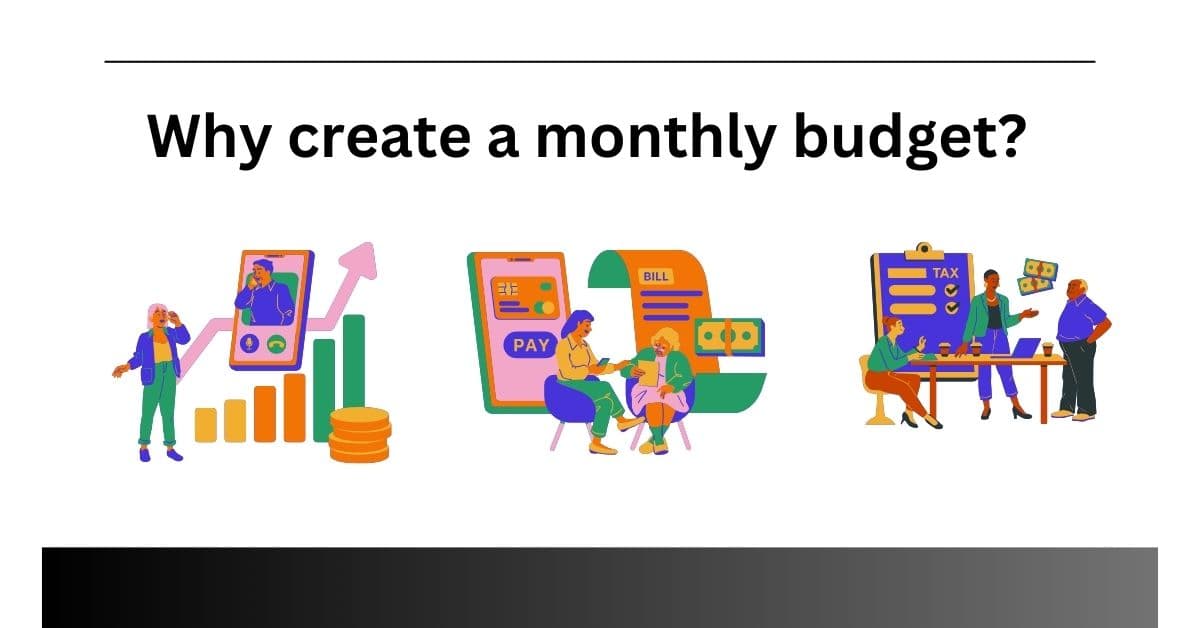Monthly Budgeting Made Easy for Indian Families: Managing a family is both a pleasure and a task in India. Every penny matters, whether it’s for rent in Bangalore, school fees in Delhi, or groceries for a household in Mumbai. According to economic assessments, there will be more than 400 million middle-class households by 2025, and with inflation averaging between 5 and 6%, budgeting can be a tightrope walk. Monthly budgeting is essential for both financial security and peace of mind, regardless of whether you’re a multigenerational family pooling resources in Ahmedabad, a single-income family earning ₹30,000 in a Tier-2 city like Patna, or a dual-income household making ₹1 lakh in Chennai.
We’ll look at practical ways for covering necessities, saving for objectives, and even enjoying life’s tiny pleasures—all without worrying about running out of money. These suggestions are specific to India’s distinct economic and cultural environment and range from using the 50-30-20 rule to reducing hidden expenses and organising festivities. Budgeting has never been easier because to the explosion of digital tools—UPI transactions reached 14.4 billion in February 2025. Let’s begin by discussing how your family may become proficient at creating a monthly budget.
The Importance of Monthly Budgeting for Indian Families
Indian households must manage their finances in a special way. A monthly salary of ₹50,000 must cover school fees (₹2,000–₹5,000), food (₹5,000–₹10,000), rent or EMIs (₹10,000–₹20,000), and unforeseen expenditures like medical bills (₹5,000) or holiday expenses (₹10,000). Purchase power is reduced by inflation (100 naira in 2020 is worth 75 naira in 2025), and pressure is increased by cultural norms such as hosting family or giving gifts on Diwali. Without a strategy, worry sneaks in, money go, and debt mounts (credit cards have 36% interest).
Why create a monthly budget?

- Covers Basics: Guarantees that rent, food, and bills are paid without exception.
- Creates Savings: 6% of ₹2,000 per month rises to ₹1.5 lakh over a ten-year period.
- Funds Objectives: Saves for a family vacation, a car, or the education of children.
- Reduces Stress: Peace for All: Clarity takes the place of financial disputes.
- Gets Ready for Surprises: manages crises without taking out loans.
The middle class in India is estimated to spend ₹10 lakh crore by 2025, therefore effective budgeting is your family’s greatest asset. Here’s how to simplify it.
Easy Monthly Budgeting for Indian Families: A Step-by-Step Guide
Are you prepared to assume command? This comprehensive guide offers 12 useful suggestions, along with examples, workarounds, and doable actions, to make monthly budgeting easier for Indian families.

Step 1: Evaluate the Income of Your Family
- How to Proceed: Total all inflows, post-tax, including salary (₹50,000), freelance income (₹5,000), and rent (₹10,000).
- Why It Is Important: Understanding your pool (for example, ₹60,000) establishes the framework for the budget.
- Deep Dive: For accuracy, use Form 16 to deduct TDS (₹2,000 on ₹50,000) or advance tax.
- Example: A family of four is supported by the Sharmas’ ₹48,000 (post-tax).
- Take action: Update monthly and list sources of income by April 15, 2025.
Step 2: Implement the 50-30-20 rule
How to Proceed:
Divide your earnings:
- 50% of needs (rent, food, bills, and fees) are ₹24,000.
- 30% wants ₹14,400 for presents, meals, and excursions.
- Savings of 20%: ₹9,600 (investments, emergencies).
The Reason It Works: ₹60,000 is made doable by striking a balance between needs, enjoyment, and the future.
Tricks: Reduce “wants” to 20% (₹12,000) and savings to 10% (₹6,000) if EMIs consume 20%.
For instance, the Vermas divide their ₹50,000 into ₹10,000 in savings, ₹15,000 in desires, and ₹25,000 in necessities.
Take action by April 20, 2025, to draft your split and test it for 30 days.
Step 3: Give housing expenses first priority
- How to Proceed: Maintain a 20–30% rent/EMI cap of ₹10,000–₹15,000 on ₹50,000.
- Why It Is Important: Needs (₹15,000) plus high rent (₹20,000) equals ₹15,000, leaving little money for savings.
- Hacks: Refinance EMIs (12% to 10%), haggle (₹500 off), or share apartments (₹7,000 vs. ₹12,000).
- For instance, the Kumars’ ₹12,000 EMI covers ₹60,000, leaving ₹48,000 available.
- Take action by April 25, 2025, to secure affordable housing.
Step 4: Make the Most of Food and Cooking
- How to Proceed: Spend between 5,000 and 10,000 for food, whether you make it yourself or get takeaway.
- The Reason It Works: It saves 3,000 per month to eat 50 meals at home instead of 150 takeout per day.
- Tips: Plan meals (saving ₹200 per week), buy in bulk (rice for ₹50/kg), and use leftovers (paratha from sabzi).
- For instance, the Sharmas saved ₹36,000 year by reducing ₹8,000 to ₹5,000.
- Take action: Shop locally and plan weekly meals before April 30, 2025.
Step 5: Simplify Utility Invoices
- How to Proceed: Limit internet, gas, water and power to 2,000–4,000.
- Why It Is Important: Cuts of ₹500 each month add up to ₹6,000 annually—more for savings.
- Hacks: include timely petrol refills (800 vs. 900), prepaid cellphone (199 vs. 399) and LED lights (200 off).
- For instance, the Vermas’ ₹3,500 bill decreased to ₹2,500–₹12,000 year.
- Take action: By May 05, 2025, adopt energy-saving practices.
Step 6: Set aside money for children’s education
- How to Proceed: Set aside ₹2,000 to ₹5,000 for activities, books, and fees.
- The Reason It Works: By planning, you may avoid loans—₹3,000 per month for school equals ₹36,000 year.
- Purchase used books for ₹500 instead of ₹1,000 and take advantage of free online courses for ₹0 instead of ₹2,000.
- For instance, the Kumars’ ₹3,000 fees covered ₹50,000 with no debt.
- Take action: By May 10, 2025, list the expenses of education.
Step 7: Create an emergency fund
- How to Proceed: Save 3-6 months’ worth of costs (between ₹90,000 and ₹1.8 lakh on a budget of ₹30,000).
- Why It Is Important: covers job loss or medical expenses (₹20,000)—no EMI defaults.
How: 6-7 percent in a liquid fund, between ₹1,000 and ₹3,000 each month. - For instance, the Sharmas saved ₹48,000 over two years with ₹2,000 every month.
- Take action by May 15, 2025, to begin the ₹1,000 buffer.
Step 8: Begin Making Minor Investments
- What to Do: Invest ₹1,000 to ₹5,000 each month in RD (6-7%) or SIPs (Nifty 50).
- The Reason It Works: Funding for children’s college: ₹2,000 per month at 12% = ₹4.6 lakh over ten years.
- Hacks: auto-debit for discipline, ₹500 SIPs, ₹1.15 lakh in ten years.
- For instance, in only three years, the Vermas’ ₹3,000 SIP increased to ₹1 lakh.
- Take Action: By May 20, 2025, begin a Groww SIP.
Step 9: Reduce Your Lifestyle Expenses
- What to Do: Spend no more than 5,000 to 10,000 on meals, films, and shopping.
- Why It Is Important: Savings are reduced—₹5,000 frees ₹10,000—when ₹15,000 “wants” on ₹50,000.
- Hacks: Shop discounts (₹1,000 off), dine out once (₹500), and share OTT (₹200 vs. ₹500).
- For instance, the Kumars saved ₹60,000 year by reducing ₹10,000 to ₹5,000.
- Action: Use PhonePe to track and set a ₹5,000 limit by May 25, 2025.
Step 10: Make Plans for Holidays
- How to Proceed: For Diwali, Holi, and weddings, set aside ₹1,000–₹3,000 every month (₹12,000–₹36,000 annually).
- The Reason It Works: avoids credit (36% interest)—planned versus borrowed presents of ₹10,000.
- Hacks: Purchase early (₹100 off pre-festive) and make your own presents (₹200 vs. ₹500).
- For instance, the Sharmas were debt-free for Diwali and saved ₹24,000, or ₹2,000 every month.
- Take action: By May 30, 2025, establish a celebratory fund.
Step 11: Make Use of Electronic Resources
- What to Do: Use apps like Google Pay and Walnut to track spending and get cashback.
- Why It Is Important: Cashback of ₹300 per month with monitoring savings of ₹1,000 equals ₹15,600 annually.
- Hacks: include budget applications (ET Money—5 minutes each day) and Link UPI (₹50 back on ₹500).
- For instance, the Vermas’ ₹6,000 annual payback is equal to ₹500 every month.
- Take action by June 05, 2025, by downloading Walnut.
Step 12: Examine and Modify Every month
- How to Proceed: Compare spending against budget: ₹48,000 for ₹50,000? Take ₹2,000 off.
- The Reason It Works: identifies leaks (₹1,000 dining)—maintains objectives.
- Hacks: Celebrate savings (₹1,000 treat) and have a family gathering with a ₹500 “fun” limit.
- For instance, the Kumars prepaid ₹24,000 in EMIs and saved an additional ₹2,000.
- Take action by June 10, 2025, to review April 2025 spending.
Budget Examples for Indian Families

₹30,000 Income (Tier-2 City, Single-Income)
Post-tax income: ₹29,000
50% of needs: ₹14,500
- ₹7,000 is the rent.
- Food costs ₹4,000.
- ₹1,500 for utilities.
- The cost is ₹1,000.
- Transportation: 1,000 naira.
30% of ₹8,700 is spent on wants (clothing, food, etc.).
20% savings: ₹5,800 (₹2,800 for festivities, ₹2,000 for emergencies, and ₹1,000 for SIP).
Income of ₹50,000 (Metro, Dual-Income)
Post-tax income: ₹48,000.
50% of needs: ₹24,000.
- EMI: 12,000 rupees.
- Food costs ₹6,000.
- ₹2,500 for utilities.
- The cost is ₹2,000.
- Transportation: 1,500 naira.
Thirty percent wants: ₹14,400.
₹9,600 in savings (20%) (₹3,600 buffer, ₹3,000 SIP, and ₹3,000 emergency).
Advantages of Simple Monthly Budgeting
- Control: No surprises—all rupees are accounted for.
- Savings: ₹8 lakh over ten years, or ₹5,000 per month at a rate of 7%.
- ₹1 lakh for schooling within five years is the target.
- Peace: A contented family with no debt concern.
- Flexibility: a contingency of ₹2,000.
Examples from Real Life
The Small-Town Plan of the Sharmas, a Lucknow family of four earning ₹30,000 per month:
- ₹15,000 is needed for food and rent.
- Desires: ₹8,000 for excursions.
- Monthly savings: ₹2,000—2 years’ worth of fees saved: ₹48,000.
- They claim that budgeting is their anchor.
The Vermas’ Metro Balance Vermas, a Mumbai-based couple earning ₹60,000 each month:
- ₹30,000 is needed for bills and EMI.
- Desires: ₹15,000 for meals.
- Savings: ₹1.5 lakh over three years—₹5,000 SIP.
- They say, “We save and we live.”
The festive victory of the Kumars, a Pune-based joint family earning ₹50,000 per month:
- ₹25,000 is needed for meals and costs.
- Desires: ₹10,000 (engaging).
- Monthly savings: ₹3,000; Diwali savings: ₹36,000.
- They say, “No loans this year.”
Additional Budgeting Advice for Families in India
- Purchase in bulk: Save ₹200 by stocking dal during discounts.
- Strike a deal: ₹5,200 annually—₹100 off vegetables every week.
- DIY: ₹100 vs. ₹300 for homemade snacks.
- Teach kids to save money by spending ₹500 less on toys.
- Digital Offers: ₹500 with UPI and ₹100 in cashback.
- Earn extra money by instructing for ₹2,000 a month.
- Learn: Look for advice on YouTube (e.g., Labour Law Advisor).
Typical Problems and Their Solutions
- Problem: Increasing prices (₹6,000 for meals).
Solution: Save ₹1,000 by cooking wisely and buying in bulk. - Problem: EMI pressure (₹15,000) is the challenge.
Solution: Refinance (12% to 10%)—₹2,000 less is the answer. - Problem: The problem is that there are no savings.
Solution: Start with a ₹500 SIP and reduce “wants” by ₹1,000. - Problem: Festive overspending is the challenge.
Solution: Prepare ₹12,000 and save ₹1,000 every month. - Problem: Disagreements inside the family.
Solution: Talk about goals and set a ₹2,000 “fun” limit.
The Benefits of Budgeting for Indian Families
Families in India spend ₹10 lakh crore year; your spending plan determines your future:
- Cultural Fit: Strikes a balance between conserving money and customs (festivals).
- Digital Edge: 70 million consumers find that UPI and apps make monitoring easier.
- Economic Push: Efficiency is required due to inflation; ₹5 saved equals ₹5 earned.
Resources and Tools
- Apps: Groww (SIPs), Walnut (tracking), and PhonePe (cashback).
- Websites: RBI (savings) and Moneycontrol (advice).
- Free resources: include YouTube lessons and Google Sheets templates.
- Communities: Family budgeting WhatsApp groups.
Make a budget now
Now take control of your family’s finances:
- Income must be listed before April 15, 2025.
- Budget draft due on April 25, 2025.
- Before May 05 , 2025, save ₹1,000.
Making a budget is a freedom, not a work. Spread the word about this book to your neighbours or family to start a financial revolution. These actions may help any Indian family prosper!
Smart Ways to Budget Salary with EMIs Every Month
Smart Budgeting for Women: Take Control of Your Finances
30-Days Rule in Budgeting: The Secret to Smart Spending in India!


Very helpful